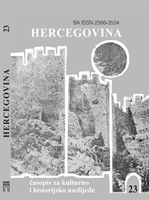PRILOG PROUČAVANJU HERCEGOVAČKIH STAMBENO-FORTIFIKACIONIH OBJEKATA (KULA) IZ OSMANSKOG PERIODA SA POSEBNIM FOKUSOM NA PODRUČJE MOSTARA
A CONTRIBUTION TO THE STUDY OF HERZEGOVATI OF RESIDENTIAL AND FORTIFICATION BUILDINGS (TOWERS) FROM THE OTTOMAN PERIOD WITH A SPECIAL FOCUS ON THE AREA OF MOSTAR
Author(s): Faruk Taslidža, Ahmet KurtSubject(s): Cultural history, Museology & Heritage Studies, Architecture, Social history, 17th Century, 18th Century, 19th Century, The Ottoman Empire, Sociology of Art, History of Art
Published by: Fakultet humanističkih nauka, Univerzitet »Džemal Bijedić« u Mostaru
Keywords: towers; Herzegovina; Mostar; fortifications; field; village; property; family; walls; loopholes; devastation; geolocation;
Summary/Abstract: As early as the 17th century, due to deteriorating security conditions, the construction of residential and fortification buildings (towers) began in Herzegovinian sandžak. This practice, which continued during the 18th and 19th centuries, was particularly pronounced in the rural areas west of the Neretva River, as well as in the fertile regions of the Trebinje Nahija. New research indicates that in this regard, the city of Mostar and its wider surroundings are no exception, where we recorded 49 such towers, which is certainly not a final number. The towers (mostly on two floors) were built according to plan, in strategic places and with quality materials. In addition to housing, they served as strong defensive fortifications in wartime conditions. They belonged to respectable and wealthy Bosniak families, and were raised on their estates. Unfortunately, the demolition of these buildings was a continuous phenomenon, accelerated in the era of modernization. As for the Mostar area, most of the towers are completely destroyed today, without any remains. It is certain that the competent institutions should finally show interest in what is still left of these significant historical monuments from the Ottoman era. It is necessary to take concrete steps in order to rehabilitate, protect and culturally affirm them.
Journal: Hercegovina
- Issue Year: 2024
- Issue No: 23
- Page Range: 41-79
- Page Count: 39
- Language: Bosnian

